Tourism Marketing & Visitor Attraction Management
VerifiedAdded on 2020/06/06
|14
|4017
|62
AI Summary
This assignment delves into the crucial aspects of tourism marketing and visitor attraction management. It examines various marketing strategies employed to promote tourist destinations and attractions, while also analyzing the challenges and best practices in managing these attractions effectively. The impact of external factors such as weather, climate change, and economic conditions on tourism performance is also considered. Furthermore, the assignment discusses the evolving role of technology in shaping visitor experiences and managing attractions in a dynamic environment.
Contribute Materials
Your contribution can guide someone’s learning journey. Share your
documents today.
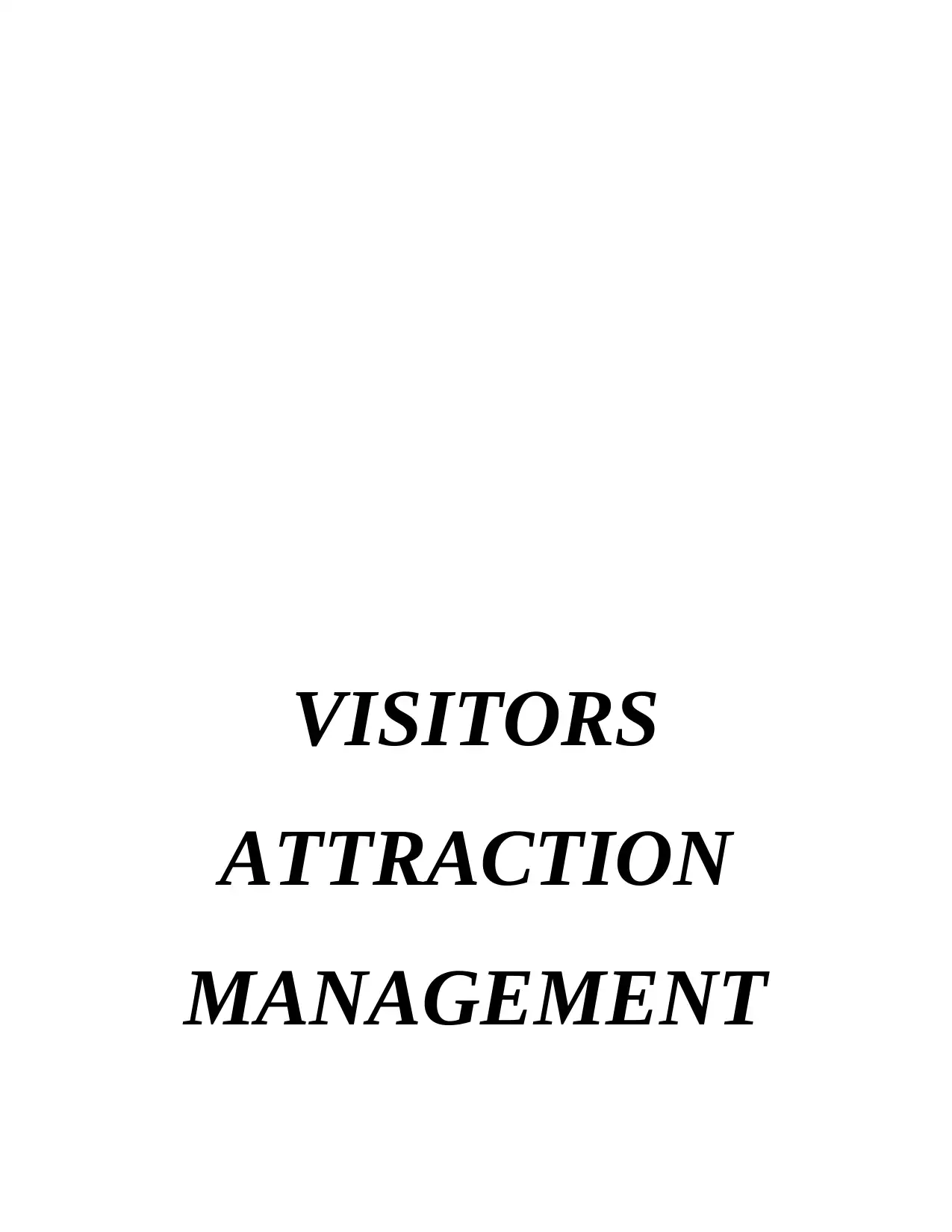
VISITORS
ATTRACTION
MANAGEMENT
ATTRACTION
MANAGEMENT
Secure Best Marks with AI Grader
Need help grading? Try our AI Grader for instant feedback on your assignments.
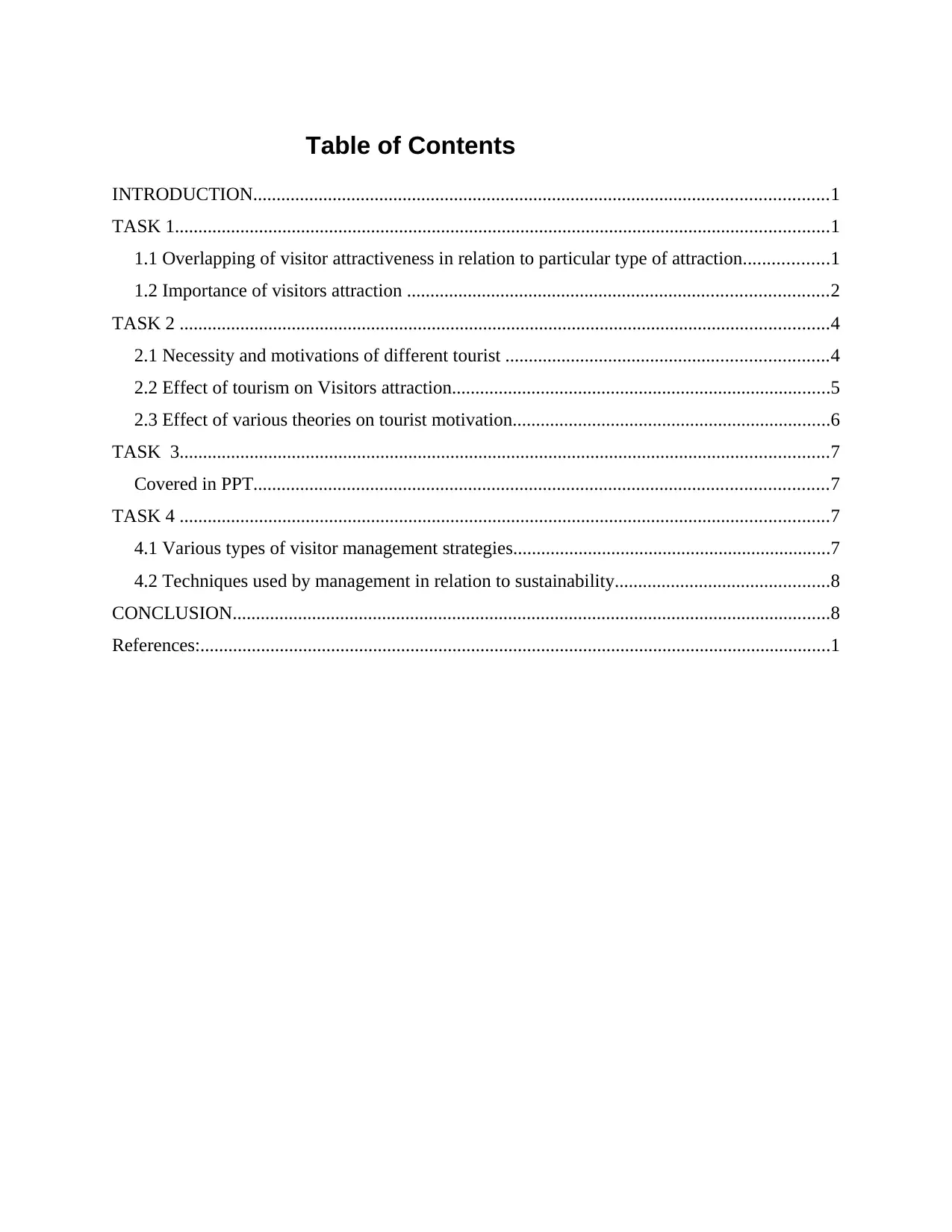
Table of Contents
INTRODUCTION...........................................................................................................................1
TASK 1............................................................................................................................................1
1.1 Overlapping of visitor attractiveness in relation to particular type of attraction..................1
1.2 Importance of visitors attraction ..........................................................................................2
TASK 2 ...........................................................................................................................................4
2.1 Necessity and motivations of different tourist .....................................................................4
2.2 Effect of tourism on Visitors attraction.................................................................................5
2.3 Effect of various theories on tourist motivation....................................................................6
TASK 3...........................................................................................................................................7
Covered in PPT...........................................................................................................................7
TASK 4 ...........................................................................................................................................7
4.1 Various types of visitor management strategies....................................................................7
4.2 Techniques used by management in relation to sustainability..............................................8
CONCLUSION................................................................................................................................8
References:.......................................................................................................................................1
INTRODUCTION...........................................................................................................................1
TASK 1............................................................................................................................................1
1.1 Overlapping of visitor attractiveness in relation to particular type of attraction..................1
1.2 Importance of visitors attraction ..........................................................................................2
TASK 2 ...........................................................................................................................................4
2.1 Necessity and motivations of different tourist .....................................................................4
2.2 Effect of tourism on Visitors attraction.................................................................................5
2.3 Effect of various theories on tourist motivation....................................................................6
TASK 3...........................................................................................................................................7
Covered in PPT...........................................................................................................................7
TASK 4 ...........................................................................................................................................7
4.1 Various types of visitor management strategies....................................................................7
4.2 Techniques used by management in relation to sustainability..............................................8
CONCLUSION................................................................................................................................8
References:.......................................................................................................................................1
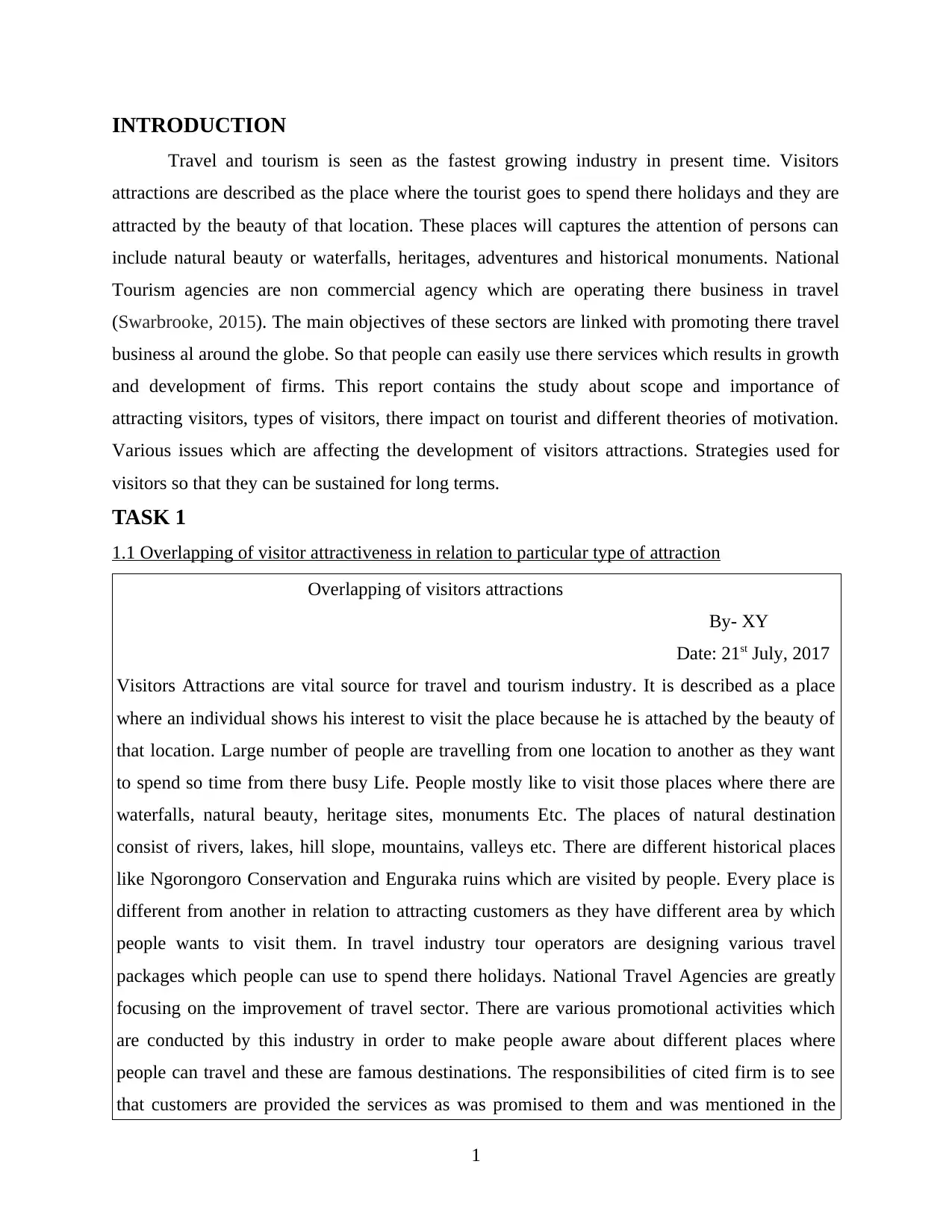
INTRODUCTION
Travel and tourism is seen as the fastest growing industry in present time. Visitors
attractions are described as the place where the tourist goes to spend there holidays and they are
attracted by the beauty of that location. These places will captures the attention of persons can
include natural beauty or waterfalls, heritages, adventures and historical monuments. National
Tourism agencies are non commercial agency which are operating there business in travel
(Swarbrooke, 2015). The main objectives of these sectors are linked with promoting there travel
business al around the globe. So that people can easily use there services which results in growth
and development of firms. This report contains the study about scope and importance of
attracting visitors, types of visitors, there impact on tourist and different theories of motivation.
Various issues which are affecting the development of visitors attractions. Strategies used for
visitors so that they can be sustained for long terms.
TASK 1
1.1 Overlapping of visitor attractiveness in relation to particular type of attraction
Overlapping of visitors attractions
By- XY
Date: 21st July, 2017
Visitors Attractions are vital source for travel and tourism industry. It is described as a place
where an individual shows his interest to visit the place because he is attached by the beauty of
that location. Large number of people are travelling from one location to another as they want
to spend so time from there busy Life. People mostly like to visit those places where there are
waterfalls, natural beauty, heritage sites, monuments Etc. The places of natural destination
consist of rivers, lakes, hill slope, mountains, valleys etc. There are different historical places
like Ngorongoro Conservation and Enguraka ruins which are visited by people. Every place is
different from another in relation to attracting customers as they have different area by which
people wants to visit them. In travel industry tour operators are designing various travel
packages which people can use to spend there holidays. National Travel Agencies are greatly
focusing on the improvement of travel sector. There are various promotional activities which
are conducted by this industry in order to make people aware about different places where
people can travel and these are famous destinations. The responsibilities of cited firm is to see
that customers are provided the services as was promised to them and was mentioned in the
1
Travel and tourism is seen as the fastest growing industry in present time. Visitors
attractions are described as the place where the tourist goes to spend there holidays and they are
attracted by the beauty of that location. These places will captures the attention of persons can
include natural beauty or waterfalls, heritages, adventures and historical monuments. National
Tourism agencies are non commercial agency which are operating there business in travel
(Swarbrooke, 2015). The main objectives of these sectors are linked with promoting there travel
business al around the globe. So that people can easily use there services which results in growth
and development of firms. This report contains the study about scope and importance of
attracting visitors, types of visitors, there impact on tourist and different theories of motivation.
Various issues which are affecting the development of visitors attractions. Strategies used for
visitors so that they can be sustained for long terms.
TASK 1
1.1 Overlapping of visitor attractiveness in relation to particular type of attraction
Overlapping of visitors attractions
By- XY
Date: 21st July, 2017
Visitors Attractions are vital source for travel and tourism industry. It is described as a place
where an individual shows his interest to visit the place because he is attached by the beauty of
that location. Large number of people are travelling from one location to another as they want
to spend so time from there busy Life. People mostly like to visit those places where there are
waterfalls, natural beauty, heritage sites, monuments Etc. The places of natural destination
consist of rivers, lakes, hill slope, mountains, valleys etc. There are different historical places
like Ngorongoro Conservation and Enguraka ruins which are visited by people. Every place is
different from another in relation to attracting customers as they have different area by which
people wants to visit them. In travel industry tour operators are designing various travel
packages which people can use to spend there holidays. National Travel Agencies are greatly
focusing on the improvement of travel sector. There are various promotional activities which
are conducted by this industry in order to make people aware about different places where
people can travel and these are famous destinations. The responsibilities of cited firm is to see
that customers are provided the services as was promised to them and was mentioned in the
1
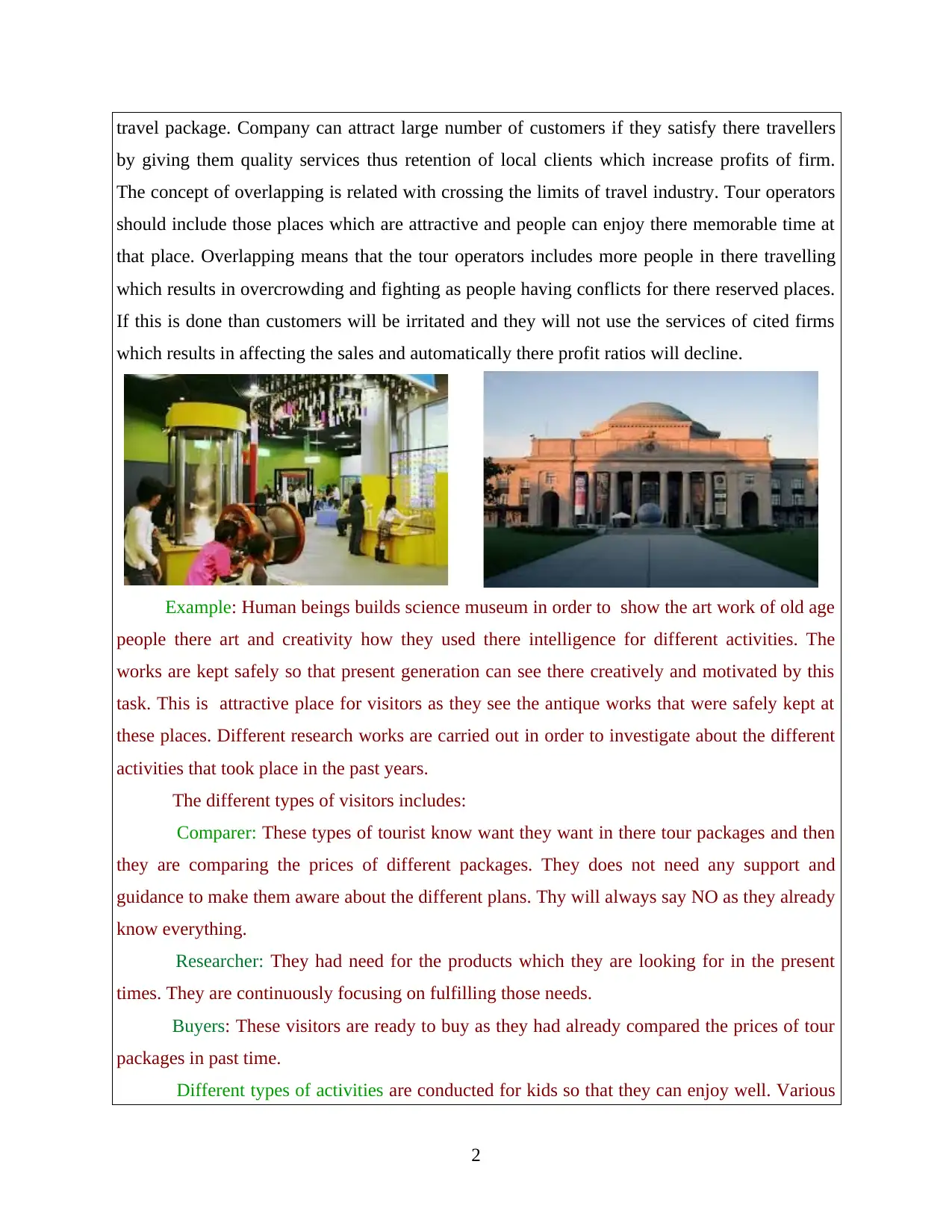
travel package. Company can attract large number of customers if they satisfy there travellers
by giving them quality services thus retention of local clients which increase profits of firm.
The concept of overlapping is related with crossing the limits of travel industry. Tour operators
should include those places which are attractive and people can enjoy there memorable time at
that place. Overlapping means that the tour operators includes more people in there travelling
which results in overcrowding and fighting as people having conflicts for there reserved places.
If this is done than customers will be irritated and they will not use the services of cited firms
which results in affecting the sales and automatically there profit ratios will decline.
Example: Human beings builds science museum in order to show the art work of old age
people there art and creativity how they used there intelligence for different activities. The
works are kept safely so that present generation can see there creatively and motivated by this
task. This is attractive place for visitors as they see the antique works that were safely kept at
these places. Different research works are carried out in order to investigate about the different
activities that took place in the past years.
The different types of visitors includes:
Comparer: These types of tourist know want they want in there tour packages and then
they are comparing the prices of different packages. They does not need any support and
guidance to make them aware about the different plans. Thy will always say NO as they already
know everything.
Researcher: They had need for the products which they are looking for in the present
times. They are continuously focusing on fulfilling those needs.
Buyers: These visitors are ready to buy as they had already compared the prices of tour
packages in past time.
Different types of activities are conducted for kids so that they can enjoy well. Various
2
by giving them quality services thus retention of local clients which increase profits of firm.
The concept of overlapping is related with crossing the limits of travel industry. Tour operators
should include those places which are attractive and people can enjoy there memorable time at
that place. Overlapping means that the tour operators includes more people in there travelling
which results in overcrowding and fighting as people having conflicts for there reserved places.
If this is done than customers will be irritated and they will not use the services of cited firms
which results in affecting the sales and automatically there profit ratios will decline.
Example: Human beings builds science museum in order to show the art work of old age
people there art and creativity how they used there intelligence for different activities. The
works are kept safely so that present generation can see there creatively and motivated by this
task. This is attractive place for visitors as they see the antique works that were safely kept at
these places. Different research works are carried out in order to investigate about the different
activities that took place in the past years.
The different types of visitors includes:
Comparer: These types of tourist know want they want in there tour packages and then
they are comparing the prices of different packages. They does not need any support and
guidance to make them aware about the different plans. Thy will always say NO as they already
know everything.
Researcher: They had need for the products which they are looking for in the present
times. They are continuously focusing on fulfilling those needs.
Buyers: These visitors are ready to buy as they had already compared the prices of tour
packages in past time.
Different types of activities are conducted for kids so that they can enjoy well. Various
2
Secure Best Marks with AI Grader
Need help grading? Try our AI Grader for instant feedback on your assignments.
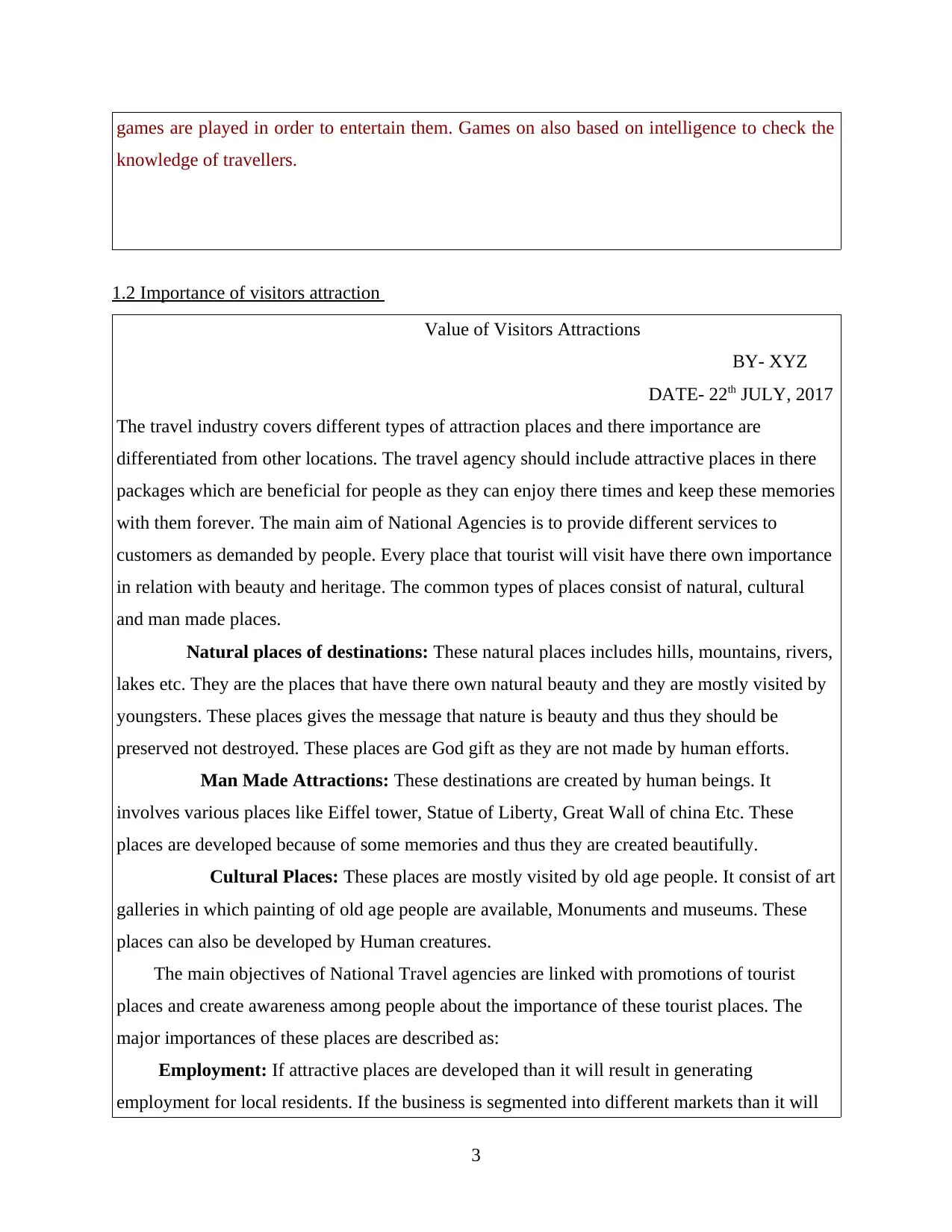
games are played in order to entertain them. Games on also based on intelligence to check the
knowledge of travellers.
1.2 Importance of visitors attraction
Value of Visitors Attractions
BY- XYZ
DATE- 22th JULY, 2017
The travel industry covers different types of attraction places and there importance are
differentiated from other locations. The travel agency should include attractive places in there
packages which are beneficial for people as they can enjoy there times and keep these memories
with them forever. The main aim of National Agencies is to provide different services to
customers as demanded by people. Every place that tourist will visit have there own importance
in relation with beauty and heritage. The common types of places consist of natural, cultural
and man made places.
Natural places of destinations: These natural places includes hills, mountains, rivers,
lakes etc. They are the places that have there own natural beauty and they are mostly visited by
youngsters. These places gives the message that nature is beauty and thus they should be
preserved not destroyed. These places are God gift as they are not made by human efforts.
Man Made Attractions: These destinations are created by human beings. It
involves various places like Eiffel tower, Statue of Liberty, Great Wall of china Etc. These
places are developed because of some memories and thus they are created beautifully.
Cultural Places: These places are mostly visited by old age people. It consist of art
galleries in which painting of old age people are available, Monuments and museums. These
places can also be developed by Human creatures.
The main objectives of National Travel agencies are linked with promotions of tourist
places and create awareness among people about the importance of these tourist places. The
major importances of these places are described as:
Employment: If attractive places are developed than it will result in generating
employment for local residents. If the business is segmented into different markets than it will
3
knowledge of travellers.
1.2 Importance of visitors attraction
Value of Visitors Attractions
BY- XYZ
DATE- 22th JULY, 2017
The travel industry covers different types of attraction places and there importance are
differentiated from other locations. The travel agency should include attractive places in there
packages which are beneficial for people as they can enjoy there times and keep these memories
with them forever. The main aim of National Agencies is to provide different services to
customers as demanded by people. Every place that tourist will visit have there own importance
in relation with beauty and heritage. The common types of places consist of natural, cultural
and man made places.
Natural places of destinations: These natural places includes hills, mountains, rivers,
lakes etc. They are the places that have there own natural beauty and they are mostly visited by
youngsters. These places gives the message that nature is beauty and thus they should be
preserved not destroyed. These places are God gift as they are not made by human efforts.
Man Made Attractions: These destinations are created by human beings. It
involves various places like Eiffel tower, Statue of Liberty, Great Wall of china Etc. These
places are developed because of some memories and thus they are created beautifully.
Cultural Places: These places are mostly visited by old age people. It consist of art
galleries in which painting of old age people are available, Monuments and museums. These
places can also be developed by Human creatures.
The main objectives of National Travel agencies are linked with promotions of tourist
places and create awareness among people about the importance of these tourist places. The
major importances of these places are described as:
Employment: If attractive places are developed than it will result in generating
employment for local residents. If the business is segmented into different markets than it will
3
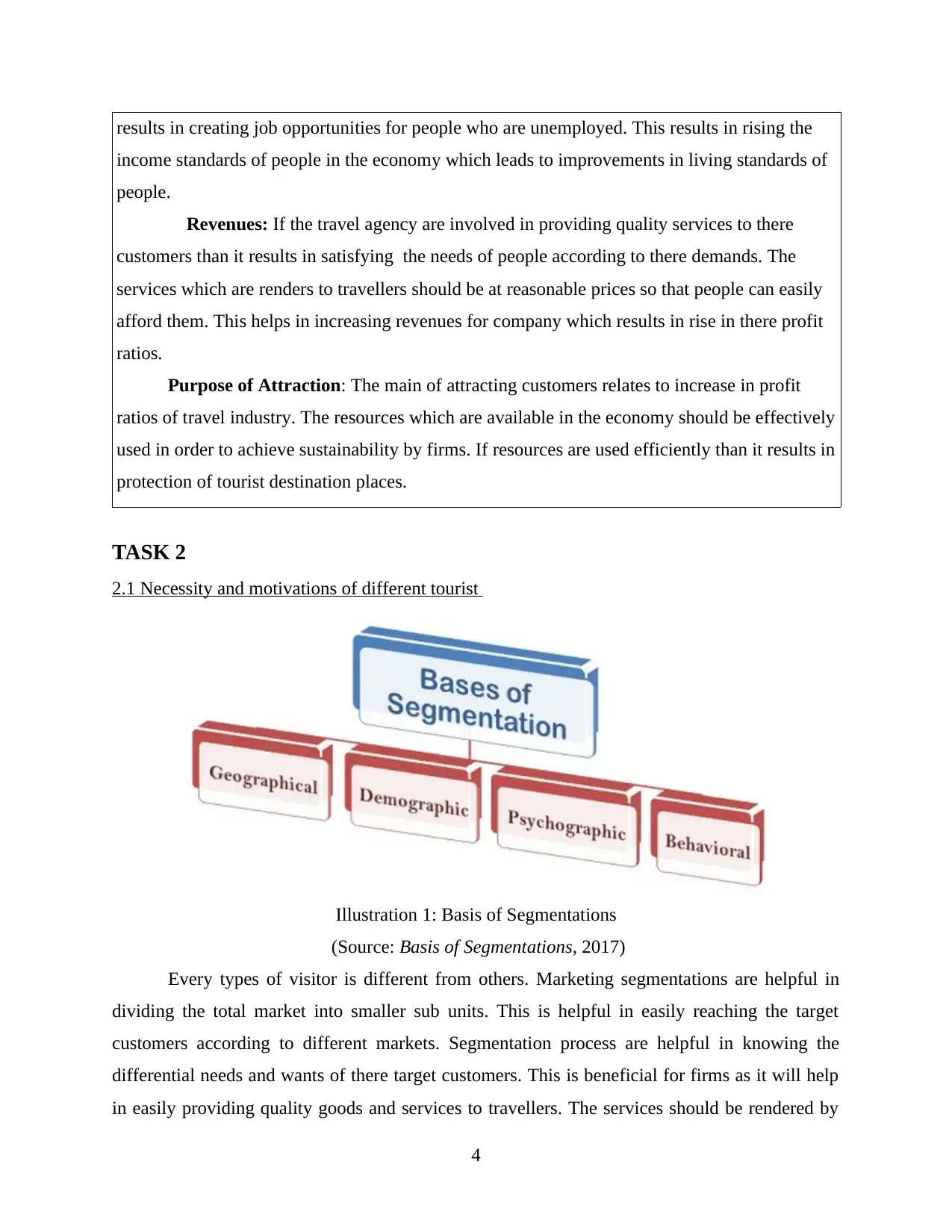
results in creating job opportunities for people who are unemployed. This results in rising the
income standards of people in the economy which leads to improvements in living standards of
people.
Revenues: If the travel agency are involved in providing quality services to there
customers than it results in satisfying the needs of people according to there demands. The
services which are renders to travellers should be at reasonable prices so that people can easily
afford them. This helps in increasing revenues for company which results in rise in there profit
ratios.
Purpose of Attraction: The main of attracting customers relates to increase in profit
ratios of travel industry. The resources which are available in the economy should be effectively
used in order to achieve sustainability by firms. If resources are used efficiently than it results in
protection of tourist destination places.
TASK 2
2.1 Necessity and motivations of different tourist
(Source: Basis of Segmentations, 2017)
Every types of visitor is different from others. Marketing segmentations are helpful in
dividing the total market into smaller sub units. This is helpful in easily reaching the target
customers according to different markets. Segmentation process are helpful in knowing the
differential needs and wants of there target customers. This is beneficial for firms as it will help
in easily providing quality goods and services to travellers. The services should be rendered by
4
Illustration 1: Basis of Segmentations
income standards of people in the economy which leads to improvements in living standards of
people.
Revenues: If the travel agency are involved in providing quality services to there
customers than it results in satisfying the needs of people according to there demands. The
services which are renders to travellers should be at reasonable prices so that people can easily
afford them. This helps in increasing revenues for company which results in rise in there profit
ratios.
Purpose of Attraction: The main of attracting customers relates to increase in profit
ratios of travel industry. The resources which are available in the economy should be effectively
used in order to achieve sustainability by firms. If resources are used efficiently than it results in
protection of tourist destination places.
TASK 2
2.1 Necessity and motivations of different tourist
(Source: Basis of Segmentations, 2017)
Every types of visitor is different from others. Marketing segmentations are helpful in
dividing the total market into smaller sub units. This is helpful in easily reaching the target
customers according to different markets. Segmentation process are helpful in knowing the
differential needs and wants of there target customers. This is beneficial for firms as it will help
in easily providing quality goods and services to travellers. The services should be rendered by
4
Illustration 1: Basis of Segmentations

the company according to the needs and demands of there customers so that it will results in
increasing growth for firms. To determines the types of tourist company should divide its
markets into three different sectors which are described as:
Demographic Factor: In this type of segment markets are divided on the basis of age,
caste, gender, size of family, colour, etc. This is helpful in easily reaching to the target customers
so that products can be easily made available to customers (Page, 2013).
Geographic: According to this markets are divided on the basis of climate, population
density, areas, subways and city. This is helpful in making the products and services available to
potential users according to there locations.
Psycho graphic factor: In this segmentation the total market areas are divided on the
basis of interest, attitude and life style of people who will be using services of travel industry.
The motivational factors includes the following aspects:
Internal Factors: These factors are directly affecting the behaviour and attitude of
persons and this impacts the business processes. It includes internal motivations of customers
which are helpful in satisfying the differential needs of there travellers. This factor includes
various aspects like safety of customers, belongingness, novelty, pride etc (Woo and et. al.,
2013).
External Factors: It results in extrinsic motivational factors. The travellers are
encouraged by these factors which consist of welfare of society, family caring and various
cultural classes.
All the above factors are helpful in motivating travellers so that they can be attracted by travel
services.
2.2 Effect of tourism on Visitors attraction
Tourism industry can greatly affect the growth and development of travel industry. There
can be impact on different tourist destinations which includes issues which are related with
traffic, impact of local community, overcrowding business, wear and tear, pollutions etc.
Over crowding: It is defined as the massive gathering of large number of people beyond
the capacity. This impacts profit ratios and business productivity as the travellers are not satisfied
with the services of cited firms. The customers are mostly attracted by the peaceful places where
they can freely spent there times and enjoy the natural beauty of those places. The tour operators
should include those places in his package which are not overcrowded. This results in increasing
5
increasing growth for firms. To determines the types of tourist company should divide its
markets into three different sectors which are described as:
Demographic Factor: In this type of segment markets are divided on the basis of age,
caste, gender, size of family, colour, etc. This is helpful in easily reaching to the target customers
so that products can be easily made available to customers (Page, 2013).
Geographic: According to this markets are divided on the basis of climate, population
density, areas, subways and city. This is helpful in making the products and services available to
potential users according to there locations.
Psycho graphic factor: In this segmentation the total market areas are divided on the
basis of interest, attitude and life style of people who will be using services of travel industry.
The motivational factors includes the following aspects:
Internal Factors: These factors are directly affecting the behaviour and attitude of
persons and this impacts the business processes. It includes internal motivations of customers
which are helpful in satisfying the differential needs of there travellers. This factor includes
various aspects like safety of customers, belongingness, novelty, pride etc (Woo and et. al.,
2013).
External Factors: It results in extrinsic motivational factors. The travellers are
encouraged by these factors which consist of welfare of society, family caring and various
cultural classes.
All the above factors are helpful in motivating travellers so that they can be attracted by travel
services.
2.2 Effect of tourism on Visitors attraction
Tourism industry can greatly affect the growth and development of travel industry. There
can be impact on different tourist destinations which includes issues which are related with
traffic, impact of local community, overcrowding business, wear and tear, pollutions etc.
Over crowding: It is defined as the massive gathering of large number of people beyond
the capacity. This impacts profit ratios and business productivity as the travellers are not satisfied
with the services of cited firms. The customers are mostly attracted by the peaceful places where
they can freely spent there times and enjoy the natural beauty of those places. The tour operators
should include those places in his package which are not overcrowded. This results in increasing
5
Paraphrase This Document
Need a fresh take? Get an instant paraphrase of this document with our AI Paraphraser
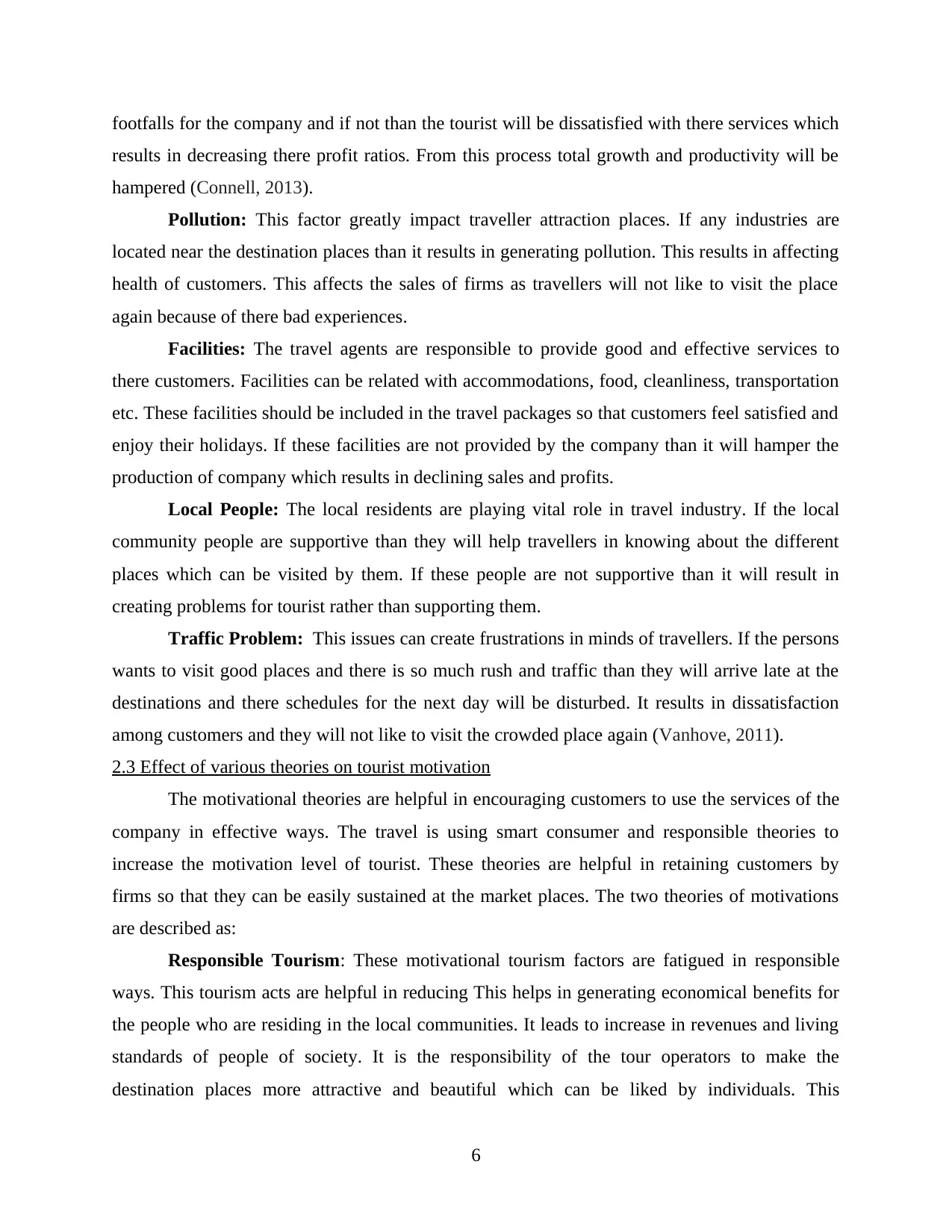
footfalls for the company and if not than the tourist will be dissatisfied with there services which
results in decreasing there profit ratios. From this process total growth and productivity will be
hampered (Connell, 2013).
Pollution: This factor greatly impact traveller attraction places. If any industries are
located near the destination places than it results in generating pollution. This results in affecting
health of customers. This affects the sales of firms as travellers will not like to visit the place
again because of there bad experiences.
Facilities: The travel agents are responsible to provide good and effective services to
there customers. Facilities can be related with accommodations, food, cleanliness, transportation
etc. These facilities should be included in the travel packages so that customers feel satisfied and
enjoy their holidays. If these facilities are not provided by the company than it will hamper the
production of company which results in declining sales and profits.
Local People: The local residents are playing vital role in travel industry. If the local
community people are supportive than they will help travellers in knowing about the different
places which can be visited by them. If these people are not supportive than it will result in
creating problems for tourist rather than supporting them.
Traffic Problem: This issues can create frustrations in minds of travellers. If the persons
wants to visit good places and there is so much rush and traffic than they will arrive late at the
destinations and there schedules for the next day will be disturbed. It results in dissatisfaction
among customers and they will not like to visit the crowded place again (Vanhove, 2011).
2.3 Effect of various theories on tourist motivation
The motivational theories are helpful in encouraging customers to use the services of the
company in effective ways. The travel is using smart consumer and responsible theories to
increase the motivation level of tourist. These theories are helpful in retaining customers by
firms so that they can be easily sustained at the market places. The two theories of motivations
are described as:
Responsible Tourism: These motivational tourism factors are fatigued in responsible
ways. This tourism acts are helpful in reducing This helps in generating economical benefits for
the people who are residing in the local communities. It leads to increase in revenues and living
standards of people of society. It is the responsibility of the tour operators to make the
destination places more attractive and beautiful which can be liked by individuals. This
6
results in decreasing there profit ratios. From this process total growth and productivity will be
hampered (Connell, 2013).
Pollution: This factor greatly impact traveller attraction places. If any industries are
located near the destination places than it results in generating pollution. This results in affecting
health of customers. This affects the sales of firms as travellers will not like to visit the place
again because of there bad experiences.
Facilities: The travel agents are responsible to provide good and effective services to
there customers. Facilities can be related with accommodations, food, cleanliness, transportation
etc. These facilities should be included in the travel packages so that customers feel satisfied and
enjoy their holidays. If these facilities are not provided by the company than it will hamper the
production of company which results in declining sales and profits.
Local People: The local residents are playing vital role in travel industry. If the local
community people are supportive than they will help travellers in knowing about the different
places which can be visited by them. If these people are not supportive than it will result in
creating problems for tourist rather than supporting them.
Traffic Problem: This issues can create frustrations in minds of travellers. If the persons
wants to visit good places and there is so much rush and traffic than they will arrive late at the
destinations and there schedules for the next day will be disturbed. It results in dissatisfaction
among customers and they will not like to visit the crowded place again (Vanhove, 2011).
2.3 Effect of various theories on tourist motivation
The motivational theories are helpful in encouraging customers to use the services of the
company in effective ways. The travel is using smart consumer and responsible theories to
increase the motivation level of tourist. These theories are helpful in retaining customers by
firms so that they can be easily sustained at the market places. The two theories of motivations
are described as:
Responsible Tourism: These motivational tourism factors are fatigued in responsible
ways. This tourism acts are helpful in reducing This helps in generating economical benefits for
the people who are residing in the local communities. It leads to increase in revenues and living
standards of people of society. It is the responsibility of the tour operators to make the
destination places more attractive and beautiful which can be liked by individuals. This
6
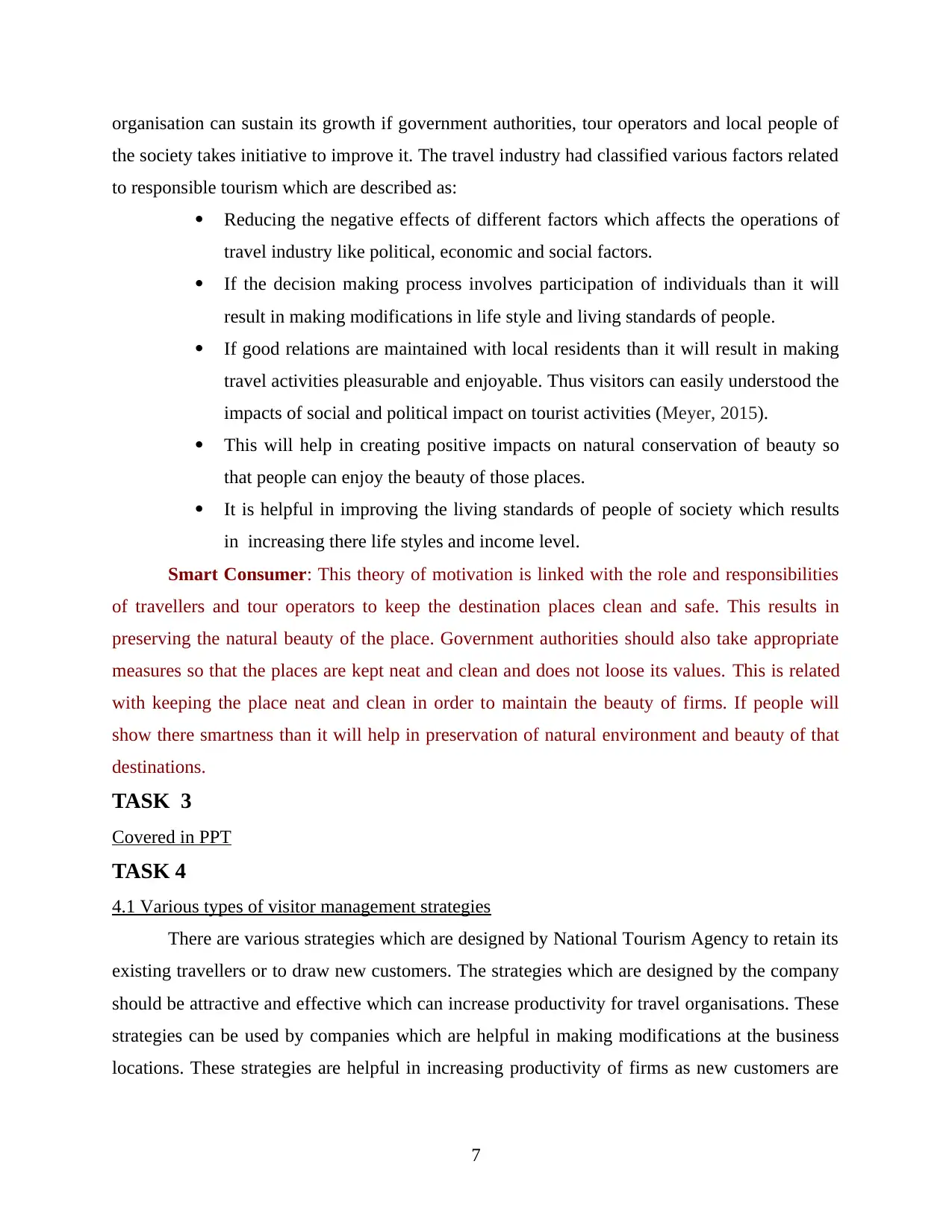
organisation can sustain its growth if government authorities, tour operators and local people of
the society takes initiative to improve it. The travel industry had classified various factors related
to responsible tourism which are described as:
Reducing the negative effects of different factors which affects the operations of
travel industry like political, economic and social factors.
If the decision making process involves participation of individuals than it will
result in making modifications in life style and living standards of people.
If good relations are maintained with local residents than it will result in making
travel activities pleasurable and enjoyable. Thus visitors can easily understood the
impacts of social and political impact on tourist activities (Meyer, 2015).
This will help in creating positive impacts on natural conservation of beauty so
that people can enjoy the beauty of those places.
It is helpful in improving the living standards of people of society which results
in increasing there life styles and income level.
Smart Consumer: This theory of motivation is linked with the role and responsibilities
of travellers and tour operators to keep the destination places clean and safe. This results in
preserving the natural beauty of the place. Government authorities should also take appropriate
measures so that the places are kept neat and clean and does not loose its values. This is related
with keeping the place neat and clean in order to maintain the beauty of firms. If people will
show there smartness than it will help in preservation of natural environment and beauty of that
destinations.
TASK 3
Covered in PPT
TASK 4
4.1 Various types of visitor management strategies
There are various strategies which are designed by National Tourism Agency to retain its
existing travellers or to draw new customers. The strategies which are designed by the company
should be attractive and effective which can increase productivity for travel organisations. These
strategies can be used by companies which are helpful in making modifications at the business
locations. These strategies are helpful in increasing productivity of firms as new customers are
7
the society takes initiative to improve it. The travel industry had classified various factors related
to responsible tourism which are described as:
Reducing the negative effects of different factors which affects the operations of
travel industry like political, economic and social factors.
If the decision making process involves participation of individuals than it will
result in making modifications in life style and living standards of people.
If good relations are maintained with local residents than it will result in making
travel activities pleasurable and enjoyable. Thus visitors can easily understood the
impacts of social and political impact on tourist activities (Meyer, 2015).
This will help in creating positive impacts on natural conservation of beauty so
that people can enjoy the beauty of those places.
It is helpful in improving the living standards of people of society which results
in increasing there life styles and income level.
Smart Consumer: This theory of motivation is linked with the role and responsibilities
of travellers and tour operators to keep the destination places clean and safe. This results in
preserving the natural beauty of the place. Government authorities should also take appropriate
measures so that the places are kept neat and clean and does not loose its values. This is related
with keeping the place neat and clean in order to maintain the beauty of firms. If people will
show there smartness than it will help in preservation of natural environment and beauty of that
destinations.
TASK 3
Covered in PPT
TASK 4
4.1 Various types of visitor management strategies
There are various strategies which are designed by National Tourism Agency to retain its
existing travellers or to draw new customers. The strategies which are designed by the company
should be attractive and effective which can increase productivity for travel organisations. These
strategies can be used by companies which are helpful in making modifications at the business
locations. These strategies are helpful in increasing productivity of firms as new customers are
7
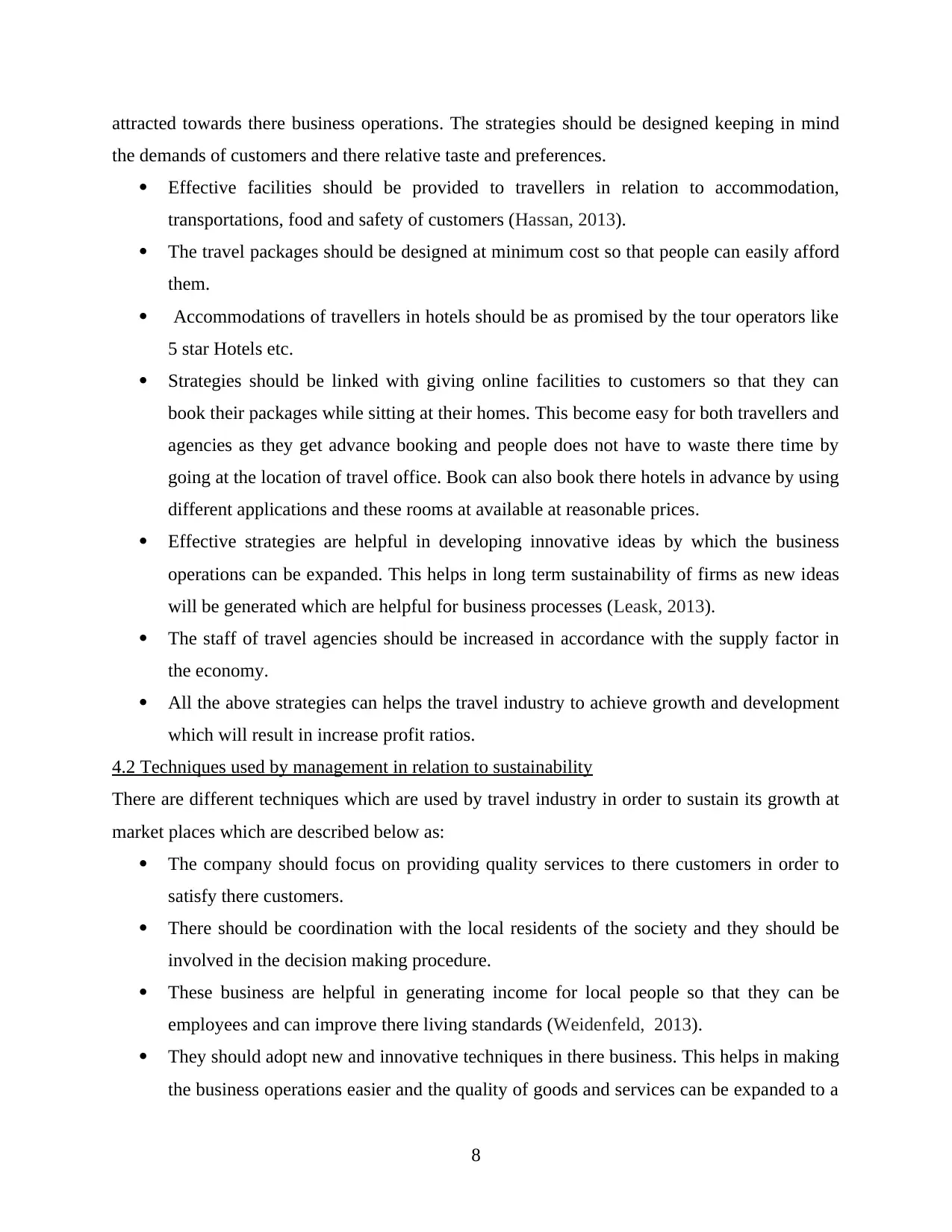
attracted towards there business operations. The strategies should be designed keeping in mind
the demands of customers and there relative taste and preferences.
Effective facilities should be provided to travellers in relation to accommodation,
transportations, food and safety of customers (Hassan, 2013).
The travel packages should be designed at minimum cost so that people can easily afford
them.
Accommodations of travellers in hotels should be as promised by the tour operators like
5 star Hotels etc.
Strategies should be linked with giving online facilities to customers so that they can
book their packages while sitting at their homes. This become easy for both travellers and
agencies as they get advance booking and people does not have to waste there time by
going at the location of travel office. Book can also book there hotels in advance by using
different applications and these rooms at available at reasonable prices.
Effective strategies are helpful in developing innovative ideas by which the business
operations can be expanded. This helps in long term sustainability of firms as new ideas
will be generated which are helpful for business processes (Leask, 2013).
The staff of travel agencies should be increased in accordance with the supply factor in
the economy.
All the above strategies can helps the travel industry to achieve growth and development
which will result in increase profit ratios.
4.2 Techniques used by management in relation to sustainability
There are different techniques which are used by travel industry in order to sustain its growth at
market places which are described below as:
The company should focus on providing quality services to there customers in order to
satisfy there customers.
There should be coordination with the local residents of the society and they should be
involved in the decision making procedure.
These business are helpful in generating income for local people so that they can be
employees and can improve there living standards (Weidenfeld, 2013).
They should adopt new and innovative techniques in there business. This helps in making
the business operations easier and the quality of goods and services can be expanded to a
8
the demands of customers and there relative taste and preferences.
Effective facilities should be provided to travellers in relation to accommodation,
transportations, food and safety of customers (Hassan, 2013).
The travel packages should be designed at minimum cost so that people can easily afford
them.
Accommodations of travellers in hotels should be as promised by the tour operators like
5 star Hotels etc.
Strategies should be linked with giving online facilities to customers so that they can
book their packages while sitting at their homes. This become easy for both travellers and
agencies as they get advance booking and people does not have to waste there time by
going at the location of travel office. Book can also book there hotels in advance by using
different applications and these rooms at available at reasonable prices.
Effective strategies are helpful in developing innovative ideas by which the business
operations can be expanded. This helps in long term sustainability of firms as new ideas
will be generated which are helpful for business processes (Leask, 2013).
The staff of travel agencies should be increased in accordance with the supply factor in
the economy.
All the above strategies can helps the travel industry to achieve growth and development
which will result in increase profit ratios.
4.2 Techniques used by management in relation to sustainability
There are different techniques which are used by travel industry in order to sustain its growth at
market places which are described below as:
The company should focus on providing quality services to there customers in order to
satisfy there customers.
There should be coordination with the local residents of the society and they should be
involved in the decision making procedure.
These business are helpful in generating income for local people so that they can be
employees and can improve there living standards (Weidenfeld, 2013).
They should adopt new and innovative techniques in there business. This helps in making
the business operations easier and the quality of goods and services can be expanded to a
8
Secure Best Marks with AI Grader
Need help grading? Try our AI Grader for instant feedback on your assignments.
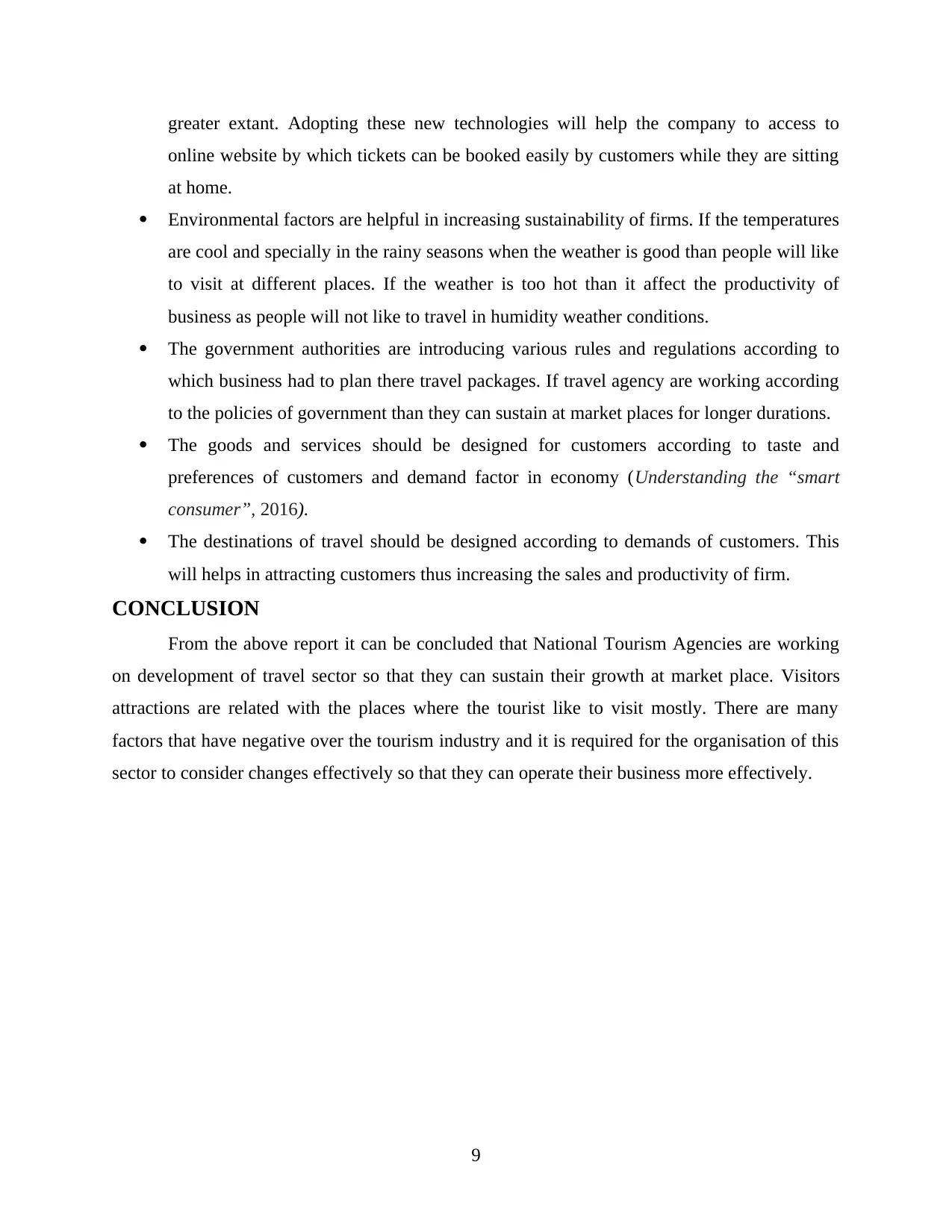
greater extant. Adopting these new technologies will help the company to access to
online website by which tickets can be booked easily by customers while they are sitting
at home.
Environmental factors are helpful in increasing sustainability of firms. If the temperatures
are cool and specially in the rainy seasons when the weather is good than people will like
to visit at different places. If the weather is too hot than it affect the productivity of
business as people will not like to travel in humidity weather conditions.
The government authorities are introducing various rules and regulations according to
which business had to plan there travel packages. If travel agency are working according
to the policies of government than they can sustain at market places for longer durations.
The goods and services should be designed for customers according to taste and
preferences of customers and demand factor in economy (Understanding the “smart
consumer”, 2016).
The destinations of travel should be designed according to demands of customers. This
will helps in attracting customers thus increasing the sales and productivity of firm.
CONCLUSION
From the above report it can be concluded that National Tourism Agencies are working
on development of travel sector so that they can sustain their growth at market place. Visitors
attractions are related with the places where the tourist like to visit mostly. There are many
factors that have negative over the tourism industry and it is required for the organisation of this
sector to consider changes effectively so that they can operate their business more effectively.
9
online website by which tickets can be booked easily by customers while they are sitting
at home.
Environmental factors are helpful in increasing sustainability of firms. If the temperatures
are cool and specially in the rainy seasons when the weather is good than people will like
to visit at different places. If the weather is too hot than it affect the productivity of
business as people will not like to travel in humidity weather conditions.
The government authorities are introducing various rules and regulations according to
which business had to plan there travel packages. If travel agency are working according
to the policies of government than they can sustain at market places for longer durations.
The goods and services should be designed for customers according to taste and
preferences of customers and demand factor in economy (Understanding the “smart
consumer”, 2016).
The destinations of travel should be designed according to demands of customers. This
will helps in attracting customers thus increasing the sales and productivity of firm.
CONCLUSION
From the above report it can be concluded that National Tourism Agencies are working
on development of travel sector so that they can sustain their growth at market place. Visitors
attractions are related with the places where the tourist like to visit mostly. There are many
factors that have negative over the tourism industry and it is required for the organisation of this
sector to consider changes effectively so that they can operate their business more effectively.
9

10
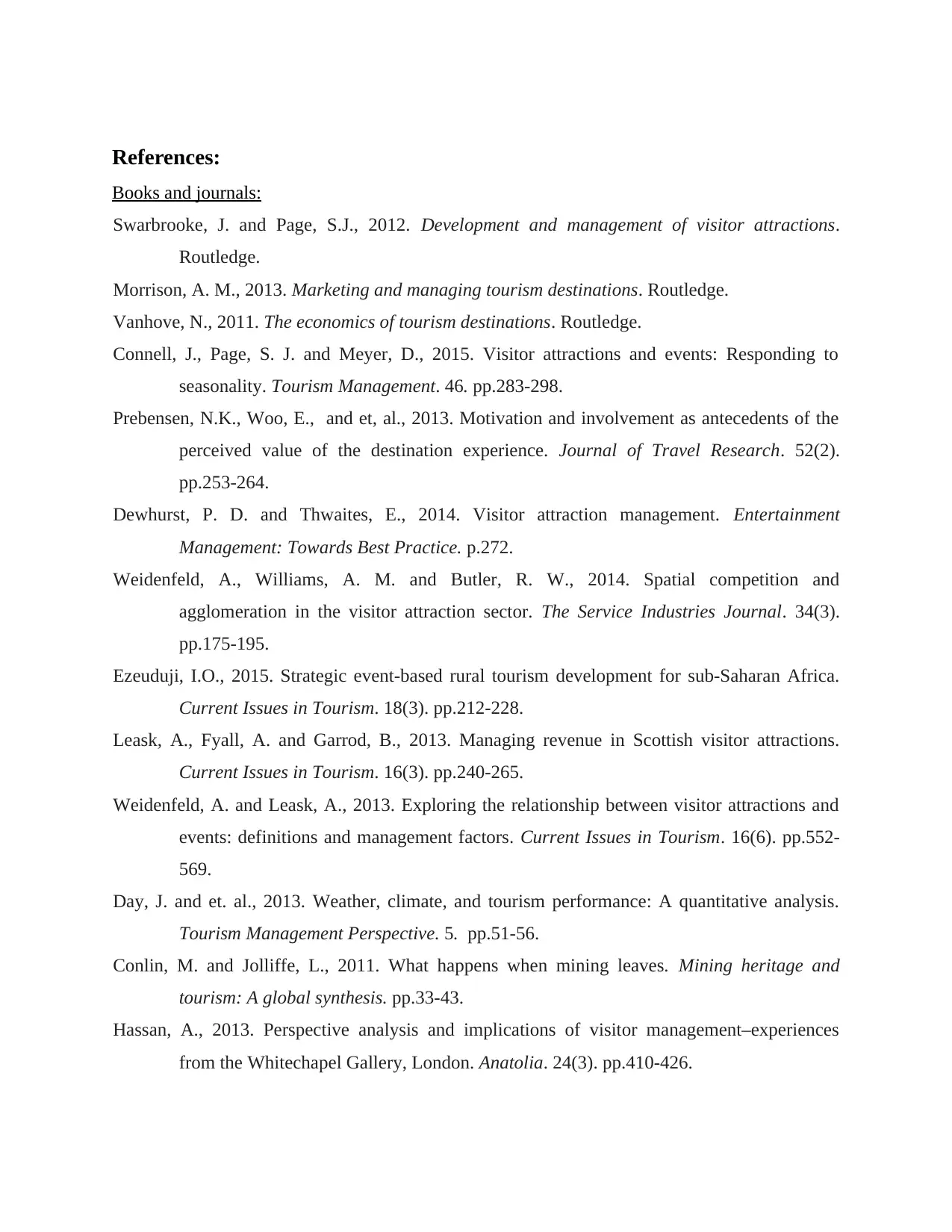
References:
Books and journals:
Swarbrooke, J. and Page, S.J., 2012. Development and management of visitor attractions.
Routledge.
Morrison, A. M., 2013. Marketing and managing tourism destinations. Routledge.
Vanhove, N., 2011. The economics of tourism destinations. Routledge.
Connell, J., Page, S. J. and Meyer, D., 2015. Visitor attractions and events: Responding to
seasonality. Tourism Management. 46. pp.283-298.
Prebensen, N.K., Woo, E., and et, al., 2013. Motivation and involvement as antecedents of the
perceived value of the destination experience. Journal of Travel Research. 52(2).
pp.253-264.
Dewhurst, P. D. and Thwaites, E., 2014. Visitor attraction management. Entertainment
Management: Towards Best Practice. p.272.
Weidenfeld, A., Williams, A. M. and Butler, R. W., 2014. Spatial competition and
agglomeration in the visitor attraction sector. The Service Industries Journal. 34(3).
pp.175-195.
Ezeuduji, I.O., 2015. Strategic event-based rural tourism development for sub-Saharan Africa.
Current Issues in Tourism. 18(3). pp.212-228.
Leask, A., Fyall, A. and Garrod, B., 2013. Managing revenue in Scottish visitor attractions.
Current Issues in Tourism. 16(3). pp.240-265.
Weidenfeld, A. and Leask, A., 2013. Exploring the relationship between visitor attractions and
events: definitions and management factors. Current Issues in Tourism. 16(6). pp.552-
569.
Day, J. and et. al., 2013. Weather, climate, and tourism performance: A quantitative analysis.
Tourism Management Perspective. 5. pp.51-56.
Conlin, M. and Jolliffe, L., 2011. What happens when mining leaves. Mining heritage and
tourism: A global synthesis. pp.33-43.
Hassan, A., 2013. Perspective analysis and implications of visitor management–experiences
from the Whitechapel Gallery, London. Anatolia. 24(3). pp.410-426.
Books and journals:
Swarbrooke, J. and Page, S.J., 2012. Development and management of visitor attractions.
Routledge.
Morrison, A. M., 2013. Marketing and managing tourism destinations. Routledge.
Vanhove, N., 2011. The economics of tourism destinations. Routledge.
Connell, J., Page, S. J. and Meyer, D., 2015. Visitor attractions and events: Responding to
seasonality. Tourism Management. 46. pp.283-298.
Prebensen, N.K., Woo, E., and et, al., 2013. Motivation and involvement as antecedents of the
perceived value of the destination experience. Journal of Travel Research. 52(2).
pp.253-264.
Dewhurst, P. D. and Thwaites, E., 2014. Visitor attraction management. Entertainment
Management: Towards Best Practice. p.272.
Weidenfeld, A., Williams, A. M. and Butler, R. W., 2014. Spatial competition and
agglomeration in the visitor attraction sector. The Service Industries Journal. 34(3).
pp.175-195.
Ezeuduji, I.O., 2015. Strategic event-based rural tourism development for sub-Saharan Africa.
Current Issues in Tourism. 18(3). pp.212-228.
Leask, A., Fyall, A. and Garrod, B., 2013. Managing revenue in Scottish visitor attractions.
Current Issues in Tourism. 16(3). pp.240-265.
Weidenfeld, A. and Leask, A., 2013. Exploring the relationship between visitor attractions and
events: definitions and management factors. Current Issues in Tourism. 16(6). pp.552-
569.
Day, J. and et. al., 2013. Weather, climate, and tourism performance: A quantitative analysis.
Tourism Management Perspective. 5. pp.51-56.
Conlin, M. and Jolliffe, L., 2011. What happens when mining leaves. Mining heritage and
tourism: A global synthesis. pp.33-43.
Hassan, A., 2013. Perspective analysis and implications of visitor management–experiences
from the Whitechapel Gallery, London. Anatolia. 24(3). pp.410-426.
Paraphrase This Document
Need a fresh take? Get an instant paraphrase of this document with our AI Paraphraser
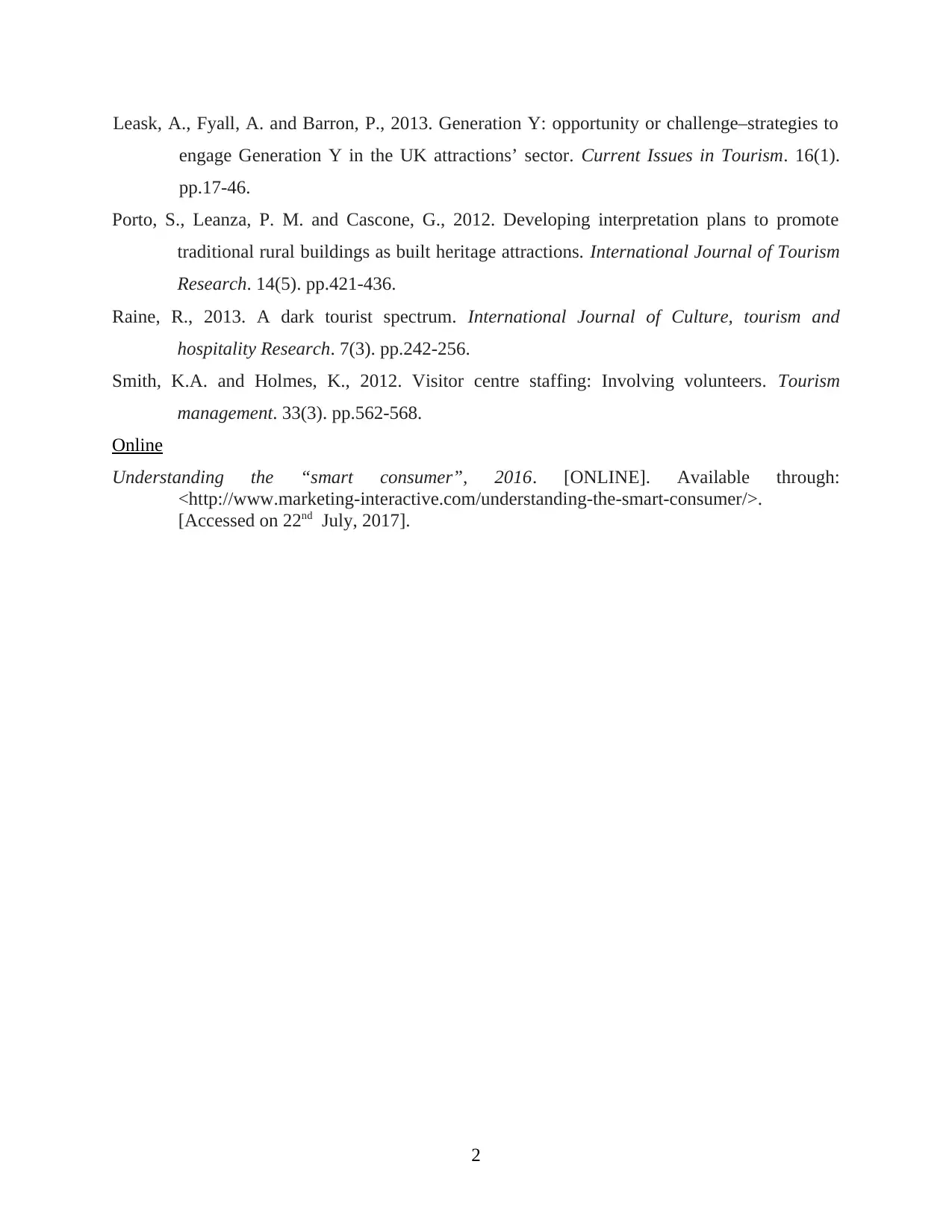
Leask, A., Fyall, A. and Barron, P., 2013. Generation Y: opportunity or challenge–strategies to
engage Generation Y in the UK attractions’ sector. Current Issues in Tourism. 16(1).
pp.17-46.
Porto, S., Leanza, P. M. and Cascone, G., 2012. Developing interpretation plans to promote
traditional rural buildings as built heritage attractions. International Journal of Tourism
Research. 14(5). pp.421-436.
Raine, R., 2013. A dark tourist spectrum. International Journal of Culture, tourism and
hospitality Research. 7(3). pp.242-256.
Smith, K.A. and Holmes, K., 2012. Visitor centre staffing: Involving volunteers. Tourism
management. 33(3). pp.562-568.
Online
Understanding the “smart consumer”, 2016. [ONLINE]. Available through:
<http://www.marketing-interactive.com/understanding-the-smart-consumer/>.
[Accessed on 22nd July, 2017].
2
engage Generation Y in the UK attractions’ sector. Current Issues in Tourism. 16(1).
pp.17-46.
Porto, S., Leanza, P. M. and Cascone, G., 2012. Developing interpretation plans to promote
traditional rural buildings as built heritage attractions. International Journal of Tourism
Research. 14(5). pp.421-436.
Raine, R., 2013. A dark tourist spectrum. International Journal of Culture, tourism and
hospitality Research. 7(3). pp.242-256.
Smith, K.A. and Holmes, K., 2012. Visitor centre staffing: Involving volunteers. Tourism
management. 33(3). pp.562-568.
Online
Understanding the “smart consumer”, 2016. [ONLINE]. Available through:
<http://www.marketing-interactive.com/understanding-the-smart-consumer/>.
[Accessed on 22nd July, 2017].
2
1 out of 14
Related Documents
Your All-in-One AI-Powered Toolkit for Academic Success.
+13062052269
info@desklib.com
Available 24*7 on WhatsApp / Email
![[object Object]](/_next/static/media/star-bottom.7253800d.svg)
Unlock your academic potential
© 2024 | Zucol Services PVT LTD | All rights reserved.





